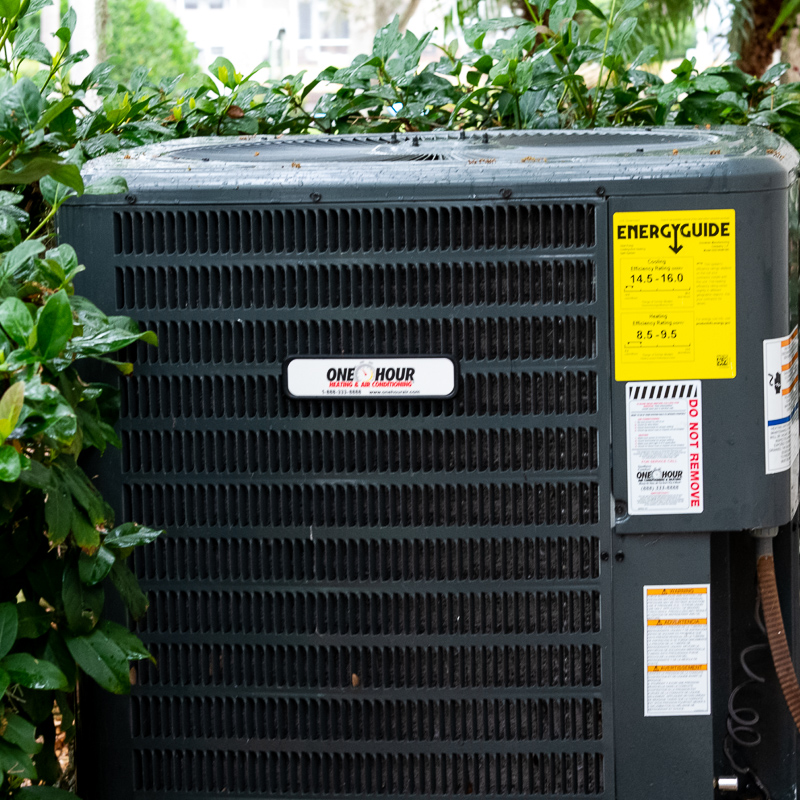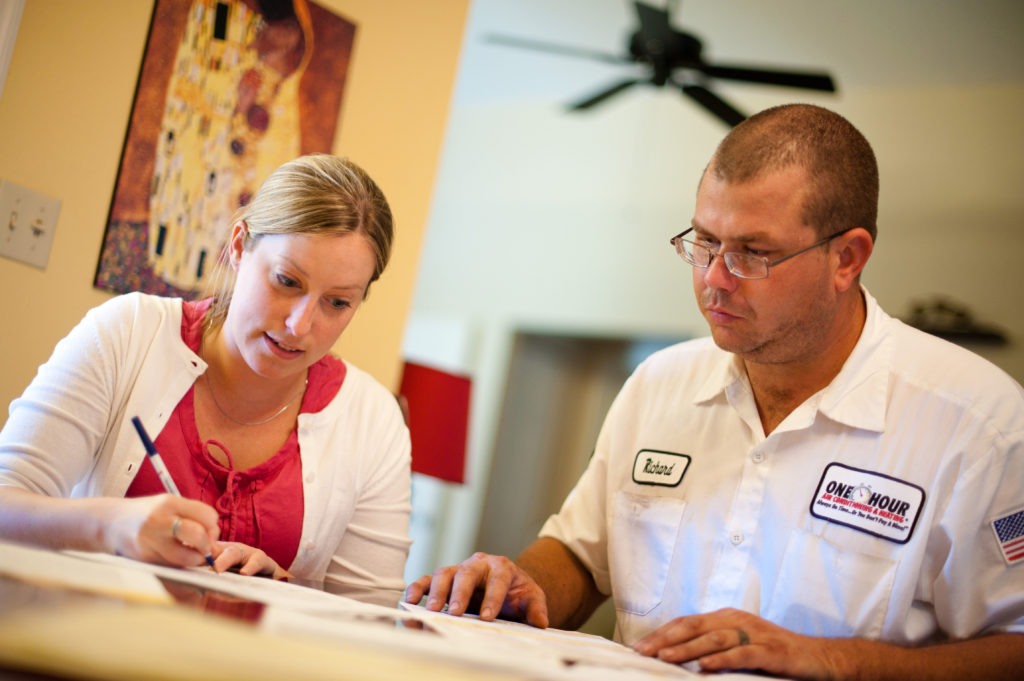With regular maintenance and repairs, your HVAC system can last 15 to 20 years before you need to replace it. When a heating or air conditioning system begins to break down, the cost of repairs becomes greater than the cost of a replacement.
Many other factors can contribute to the problem, as well, such as air leaks in your home or an accumulation of dust around your unit. A professional inspection can help you find out exactly what your HVAC system needs to continue keeping your home comfortable.
 When to Replace Your Air Conditioner
When to Replace Your Air Conditioner
Before a replacement becomes necessary, you’ll be able to keep your AC running simply by replacing worn-out parts as they stop working. The major components of an AC system are the condenser coil, evaporator coil and compressor.
The condenser coil is an outdoor component that dissipates heat as it flows out of your home through the evaporator. Although the condenser requires relatively infrequent repairs, it can cause efficiency problems when it begins to fail.
The evaporator coil is an indoor component that acts like a heat sink in your home and redirects heat outdoors to the condenser. It uses a compressed liquid refrigerant such as Freon to absorb environmental heat and then release it outdoors.
After 12 to 15 years of operation, the evaporator coil can begin to leak refrigerant and struggle to remove the heat in your home. When it begins to leak, you’ll notice the air in your home feeling warm even when you set your thermostat low.
The compressor is the main component of your AC, and when it dies, you’ll have to replace the whole system. Compressors are indoor components that pump refrigerant to the evaporator and move heat outdoors to the condenser. They typically last 15 to 20 years although some can keep working for 40 years or longer.
When to Replace Your Heater
Heaters are simpler than air conditioners, so they have fewer components that can break down. The main component of a heater is the furnace, which can last 20 years before dying. The other components are the duct system and the thermostat, which perform the same functions for your heater as for your AC.
When your furnace gets close to the end of its lifespan, it will require more frequent and costly heating repair. For the first 12 years of its operation, a furnace will run smoothly and quietly with occasional minor repairs. During this time, you may need to replace the ignitor, pressure switch, sequencer or transformer.
After 12 years, you may need to replace more expensive parts, such as the heat exchanger, blower motor, inducer motor or gas valve. As your furnace ages, its inefficiency increases until it becomes unaffordable to repair. By the time it reaches 20 years old, you’ll almost certainly need to buy a new one.
How to Know If Repairs Are Cost-Effective
It’s generally more cost-effective to replace parts as they wear out than to replace the entire system during its service life. When an AC or heating system reaches its life expectancy, the cost of repairs will become unsustainable. While a new AC or heater is a big-ticket item, it will soon begin to save you money on utilities and repairs.
A new system will function with minimal maintenance and repairs for over a decade before larger parts begin to break down. Moreover, new systems are generally more efficient than older ones, especially long-running systems with many flaws.
With a new heater or AC, you could notice significantly improved temperatures throughout your home. Ultimately, it’s up to you and your HVAC service technician to decide when to replace your system. There isn’t a set expiration date on any unit.
Which Parts Require the Most Frequent Repairs?
Over the lifetime of your system, you’ll have to replace certain parts more frequently than others. For example, you should replace your air filter every 30 days. In general, the more frequently a component wears out, the less expensive it is to replace.
The blower fan is a mechanical part that runs continuously whether you’re using the heater or AC. When it breaks down, a technician will have to perform a repair, which is a quick, inexpensive process. Other parts that frequently break down are the capacitors, contactors and evaporator. Capacitors and contactors regulate the power flowing through your outdoor condenser and into the indoor compressor. They handle high levels of electricity and heat, so they wear out quickly.
Because these parts are easily accessible within the condenser housing, a technician can usually replace them in just a few minutes. Likewise, when your evaporator is leaking refrigerant, a technician can often locate the leak and fix it during a brief service call. These common repairs are affordable and simply go along with owning an AC.
How Long Do HVAC Parts Last?
The longest-lasting part of an AC is the compressor, which can sometimes last as long as 40 years before giving out. However, because the compressor is irreplaceable, the whole system will die along with it.
On an AC, the condenser and evaporator coils can last 10 to 12 years before needing repairs or replacement. On a furnace, the heat exchanger can last about the same amount of time before it needs repairs. Many manufacturers offer warranties for the first two to five years of ownership, so you can expect your unit to function reliably during that time.
The parts of a furnace that require seasonal replacements are the pilot light, blower belt and bearings. Like the short-lived parts of an AC, these furnace components are relatively inexpensive to replace.
What Is the Cost to Repair AC Components?
Depending on the component, replacement parts can range from under $100 to $2,000 or more. Relatively inexpensive parts include the capacitor, thermostat, blower fan and air filter. Capacitors wear out more frequently than other parts and cost around $150 to $200 to replace. Blower fans also require somewhat frequent replacement and cost $200 to $500 for parts and labor.
More expensive parts include the evaporator, condenser and compressor, which range from $2,000 to $5,000. Since a new AC unit costs around $5,000 to $6,000, replacing the most expensive parts doesn’t always make sense, especially if the unit is nearing the end of its service life. A technician can help you decide whether to replace high-dollar parts or invest in a new unit.
What Is the Cost to Repair Heating Components?
Heating repairs are comparable to AC repairs. You can expect to pay around $350, on average, for parts and labor when your furnace breaks down. Minor repairs, such as thermostat or igniter replacements, typically cost $150 to $200.
Because a furnace has fewer parts than an AC, there aren’t as many components to replace. When a part breaks down and causes your furnace to malfunction, a technician may be able to repair it and save you the cost of a replacement.
For example, the difference in cost of repairing and replacing a blower motor is around $1,500. If the blower goes out on your furnace, it will fail to move warm air through your house. It’s the most expensive part of a heating system to replace. If it breaks down after your unit has passed the end of its service life, you should consider buying a new furnace.
Do the Energy Savings Really Offset Replacement Costs?
By investing in a new system, not only will you save tens of thousands of dollars on repairs over the next decade, but you’ll save thousands on energy bills, as well. An older system accumulates entropy from wear and tear, making it increasingly inefficient. New ACs and heaters have energy-saving features and more advanced engineering than the units from 10 or 20 years ago.
Replacing your system will cost at least $5,000, but continuing to use a worn-out unit could cost much more. An inefficient system will struggle to heat or cool your home even as it draws more power than a new system would. When your system nears the end of its service cycle, a technician can tell you how much money you could save by investing in a new one.
 Homeownership and Other Cost Considerations
Homeownership and Other Cost Considerations
If you’re planning to sell your home in the next year, it might not make sense to replace your AC or heater before you leave. In this case, you can simply replace worn-out parts and continue using the existing unit until you sell your property.
Other factors to consider include the environmental impact of an older unit as well as the impact it will have on your home. Older units often leak Freon, which can contribute to greenhouse gas emissions. They also contribute to higher humidity in the home, which can damage fabric, carpet and walls.
Whether you’re looking for AC repair services or a new furnace installation, you can count on us at One Hour Magic. We offer duct cleaning services and full-service repairs for all types of air conditioning systems. Call us today to learn more.